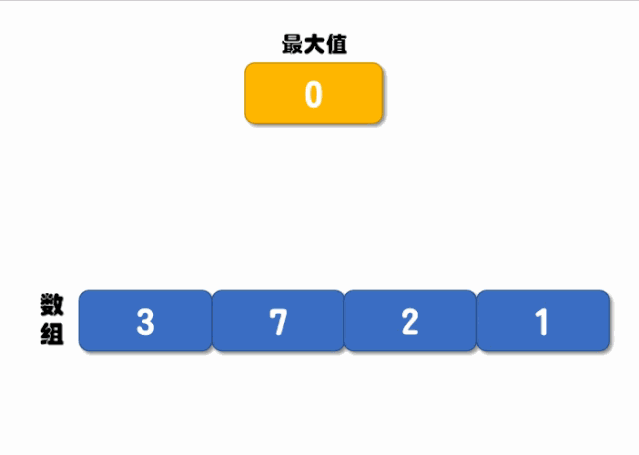How to find the maximum value through recursive comparison in Java
Recursive comparison
The core of recursive comparison is to first define two positions (starting position and ending position), and compare the starting position and ending position each time. When the starting position is greater than the ending position, value, set the maximum value to the value of the start position, then set the end position -1 (move one bit forward), and continue the recursive call; on the contrary, when the value of the end position is greater than the start position, set the maximum value to the end position value, set the starting position to 1 (move one bit back), continue to call the comparison recursively, and return the maximum value until the end of the recursion. The execution process is as shown in the figure below:

The implementation code is as follows:
<code>public class ArrayMax {<br> public static void main(String[] args) {<br> int[] arr = {3, 7, 2, 1, -4};<br> int max = findMaxByRecursive(arr, 0, arr.length - 1, 0); // 根据 Collections 查找最大值<br> System.out.println("最大值是:" + max);<br> }<br><br> /**<br> * 根据递归查询最大的值<br> * @param arr 待查询数组<br> * @param head 最前面的元素的下标<br> * @param last 最末尾的元素的下标<br> * @param max (临时)最大值<br> * @return 最大值<br> */<br> private static int findMaxByRecursive(int[] arr, int head, int last, int max) {<br> if (head == last) {<br> // 递归完了,返回结果<br> return max;<br> } else {<br> if (arr[head] > arr[last]) {<br> max = arr[head]; // 赋最大值<br> // 从后往前移动递归<br> return findMaxByRecursive(arr, head, last - 1, max);<br> } else {<br> max = arr[last]; // 赋最大值<br> // 从前往后移动递归<br> return findMaxByRecursive(arr, head + 1, last, max);<br> }<br> }<br> }<br>}<br></code>The execution result of the above program is:
The maximum value is: 7
The above is the detailed content of How to find the maximum value through recursive comparison in Java. For more information, please follow other related articles on the PHP Chinese website!

Hot AI Tools

Undresser.AI Undress
AI-powered app for creating realistic nude photos

AI Clothes Remover
Online AI tool for removing clothes from photos.

Undress AI Tool
Undress images for free

Clothoff.io
AI clothes remover

AI Hentai Generator
Generate AI Hentai for free.

Hot Article

Hot Tools

Notepad++7.3.1
Easy-to-use and free code editor

SublimeText3 Chinese version
Chinese version, very easy to use

Zend Studio 13.0.1
Powerful PHP integrated development environment

Dreamweaver CS6
Visual web development tools

SublimeText3 Mac version
God-level code editing software (SublimeText3)

Hot Topics
 1377
1377
 52
52
 Perfect Number in Java
Aug 30, 2024 pm 04:28 PM
Perfect Number in Java
Aug 30, 2024 pm 04:28 PM
Guide to Perfect Number in Java. Here we discuss the Definition, How to check Perfect number in Java?, examples with code implementation.
 Random Number Generator in Java
Aug 30, 2024 pm 04:27 PM
Random Number Generator in Java
Aug 30, 2024 pm 04:27 PM
Guide to Random Number Generator in Java. Here we discuss Functions in Java with examples and two different Generators with ther examples.
 Weka in Java
Aug 30, 2024 pm 04:28 PM
Weka in Java
Aug 30, 2024 pm 04:28 PM
Guide to Weka in Java. Here we discuss the Introduction, how to use weka java, the type of platform, and advantages with examples.
 Smith Number in Java
Aug 30, 2024 pm 04:28 PM
Smith Number in Java
Aug 30, 2024 pm 04:28 PM
Guide to Smith Number in Java. Here we discuss the Definition, How to check smith number in Java? example with code implementation.
 Java Spring Interview Questions
Aug 30, 2024 pm 04:29 PM
Java Spring Interview Questions
Aug 30, 2024 pm 04:29 PM
In this article, we have kept the most asked Java Spring Interview Questions with their detailed answers. So that you can crack the interview.
 Break or return from Java 8 stream forEach?
Feb 07, 2025 pm 12:09 PM
Break or return from Java 8 stream forEach?
Feb 07, 2025 pm 12:09 PM
Java 8 introduces the Stream API, providing a powerful and expressive way to process data collections. However, a common question when using Stream is: How to break or return from a forEach operation? Traditional loops allow for early interruption or return, but Stream's forEach method does not directly support this method. This article will explain the reasons and explore alternative methods for implementing premature termination in Stream processing systems. Further reading: Java Stream API improvements Understand Stream forEach The forEach method is a terminal operation that performs one operation on each element in the Stream. Its design intention is
 TimeStamp to Date in Java
Aug 30, 2024 pm 04:28 PM
TimeStamp to Date in Java
Aug 30, 2024 pm 04:28 PM
Guide to TimeStamp to Date in Java. Here we also discuss the introduction and how to convert timestamp to date in java along with examples.
 Create the Future: Java Programming for Absolute Beginners
Oct 13, 2024 pm 01:32 PM
Create the Future: Java Programming for Absolute Beginners
Oct 13, 2024 pm 01:32 PM
Java is a popular programming language that can be learned by both beginners and experienced developers. This tutorial starts with basic concepts and progresses through advanced topics. After installing the Java Development Kit, you can practice programming by creating a simple "Hello, World!" program. After you understand the code, use the command prompt to compile and run the program, and "Hello, World!" will be output on the console. Learning Java starts your programming journey, and as your mastery deepens, you can create more complex applications.




